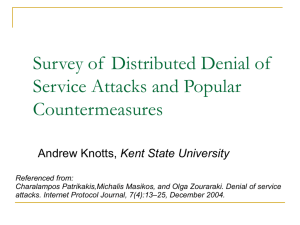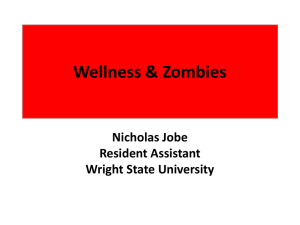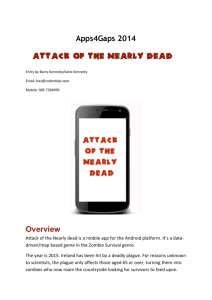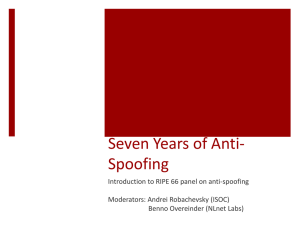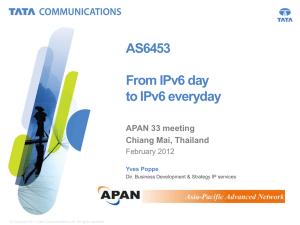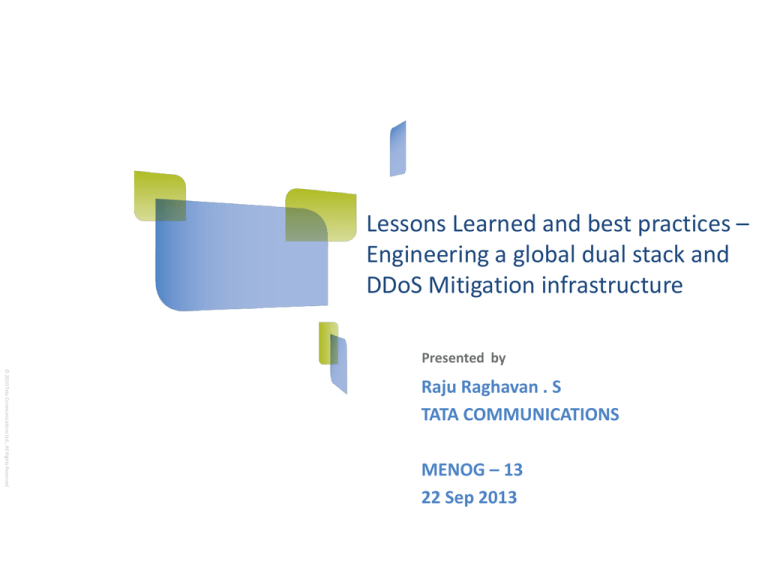
Lessons Learned and best practices –
Engineering a global dual stack and
DDoS Mitigation infrastructure
Presented by
© 2010 Tata Communications Ltd., All Rights Reserved
Raju Raghavan . S
TATA COMMUNICATIONS
MENOG – 13
22 Sep 2013
Agenda
The Context
Key Global Trends
The network journey / key learnings
Summary
Tata Communications - Context
Over 219 PoPs in
31 countries
6th largest global IP
Service Provider
13 Terabits of
round theKey
globe
benefit
owned cable
system.
Global IP Service Provider - 6,100G of
backbone capacity
Challenging Global Trends drive innovation in network
planning
Exponential traffic growth leads to
shorter planning cycles
250K hits per second
Zero Tolerance
Impact of the global trends on SP infrastructure
Planning for
Traffic
Growth
Data Plane
Netflow /
sFlow / jFlow
/ IPFIX
Backbone /
Peer /
customer link
Utilization
Capacity – 100G, 40G,
10G, 1G, STM16, STM4.,
Load Balancing – LAG,
ECMP, entropy label.
encrypted
flow, L2
PW Flow,
giant flow
Vicious
Control Plane’s
Cycle
effect on Data
Data Plane’s
effect on Control
plane
plane
CPU
Planning for
Zero
Tolerance
LFIB
FIB
L2FIB
MFIB
Fast SPF calculations
QoS
TCAM
BGP Best
External
xSTP
Adjacency
BFD NP
Scale
BGP ADD Path
BFD
LFA
FRR
EOAM
G.8032
Control Plane
Network Analytics and focused instrumentation unravel interesting perspectives
Control Plane
FIB
QoS
Routing
Context
Access
Public Cloud / Domain
Public Cloud / Domain
• 100G / 40G / LAGs
• Hot potato Routing,
Peering management,
• Multi Gigabit DDoS Attacks,
IPv6
Data Plane
BFD
lambdas
40G /
100G
Switching
Capacity
Private Cloud / Domain
Private Cloud / Domain
• VPNs, Fast Convergence,
BFD/LFA
• Multiple QoS requirements
• Application Optimization
and SLAs, zero tolerance
Food for thought
High Traffic vs. high Control
plane intensive geographies
Does economics play a role?
Converged Network Model
How does it affect planning
cycles?
De-Converged Network Model
Tata Communications deploys both converged and de-converged architecture in
different parts of the network
Globally ~2500 large DDoS attacks happen every
day (about 2.5 Mn attacks every year)
BOSS
BOT Chief
Infected
Computer
How can we defend DDoS attacks?
DDoS attacks can be mitigated using
behavioral analysis, black list filtering
,protocol validation techniques etc., in a
DDoS Scrubbing Farm
Zombies
Zombies
Zombies
DDOS Scrubbing
farm
Target /
Victim
Clean Traffic
Zombies
Zombies
Zombies
Cloud based distributed mitigation vs. in premise
mitigation
+ In premise DDoS mitigation infrastructure are not an alternative for obvious reasons .
+ Firewall, IDS, IPS , Antivirus are a different ballgame
Regional
Scrubbing Farm
Zombies
Zombies
Zombies
Target
Clean Traffic
Zombies
Zombies
Zombies
So Tata Communications has deployed a global distributed scrubbing farm that scrubs attack
traffic regionally
Anycast on-ramping
How can you seamlessly add / remove scrubbing farms as the attack evolves quickly?
Anycast GRE
Target
Zombies
Advertise /32 of the target
Case Study | Large Service provider
Large Service Provider in Asia .
Typical traffic towards one particular destination – 35- 40 Mbps
20Gbps Attack from Europe and American zombies
Case Study | Large Service provider
Bandwidth Attack – Avg Packet size = 1KB
Tata Communications IPv6 Context
14
14
CORPORATE
Learnings from the IPv6 deployment journey
• Have you tried deploying 6 PE
with a hierarchical design?
Global
backbone
• Swapping 6PE service
labels have no standard
mechanisms across
leading vendors .
•
Every vendor has a
different way of
generating the 6PE service
labels
• Tata Communications deploys a
global native dual stack
backbone with native IPv6 IGP
and BGP
Global Dual Stack IGP deployment
Integrated Topology view
V4 and v6 Topology
Multi Topology view
V4 Topology
V6 Topology
• Tata Communication's deploys Multi-topology ISIS
• This gives us the flexibility of steering IPv6 and IPv4 traffic on different topologies
as vendors evolved their IPv6 support / maturity
Summary
•
Innovation in network engineering is being driven by challenging global
network trends of exponential traffic growth vis a vis zero tolerance
expectations
•
Network analytics of control and data plane uncovers interesting
perspectives related to technical behavior of various market segments . These
insights can be innovatively applied in network engineering/design.
• Tackling todays multi gigabit DDoS attacks is best done using a global
distributed / intelligent DDoS scrubbing infrastructure. In premise DDoS
mitigation infrastructure are not an alternative.
Summary
•
Since we started our IPv6 Network journey 10 years back , we had several
learnings that prompted us to deploy a unique global dual stack and multitopology infrastructure
• Build your network infrastructure not based on “generic best practices” but
based on in-depth contextual analytics / focused instrumentation and
technical / business merit !
Thank you and Happy Innovating for your
network!


